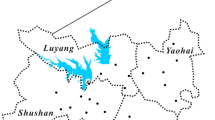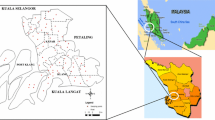Abstract
The aim of this descriptive-analytical study was to measure the concentration of heavy metals (HMs) in the leaf and bark of Ulmus carpinifolia as new biological indicators, and the ecological risk assessment of these metals in the ambient air. To achieve these goals, 48 sampling locations were selected in the city and concentration of four HMs—zinc (Zn), copper (Cu), lead (Pb), and cadmium (Cd)—was measured in the mentioned indicator using atomic absorption spectroscopy method. After this, ecological risk assessment, source appointment, and spatial distribution were conducted. In this regard, the enrichment factor (EF), potential ecological risk factor (E r), potential ecological risk index (RI), correlation coefficient (r), and other indices were calculated. The results showed that the concentration of HMs in the leaf and bark in ascending order is as Cd<Cu<Pb<Zn and Cd<Pb<Cu<Zn, respectively. The EF results indicated that the main origin of all measured HMs except Zn is anthropogenic sources. Also, the principal component analysis (PCA) and spatial distribution proved that the concentration of HMs is mainly originated from the traffic and other human activities. On the other hand, the results RI presented that the majority of locations sampled in the study area was exposed to serious ecological risk in terms of surveyed HMs. The leaf and bark of U. carpinifolia can be applied as bio-indicators of the presence of heavy metals in the ambient air and ecological risk imposed by them.







Similar content being viewed by others
References
Abdel-Ghaffar F, Abdel-Gaber R, Bashtar A-R, Morsy K, Mehlhorn H, Al Quraishy S, Saleh R (2015) Hysterothylacium aduncum (Nematoda, Anisakidae) with a new host record from the common sole Solea solea (Soleidae) and its role as a biological indicator of pollution. Parasitol Res 114:513–522
Adachi K, Tainosho Y (2004) Characterization of heavy metal particles embedded in tire dust. Environ Int 30:1009–1017
Ahmadi E, Gholami M, Farzadkia M, Nabizadeh R, Azari A (2015) Study of moving bed biofilm reactor in diethyl phthalate and diallyl phthalate removal from synthetic wastewater. Bioresour Technol 183:129–135. doi:10.1016/j.biortech.2015.01.122
Barnes D, Hamadah M, Ottaway J (1976) The lead, copper and zinc content of tree rings and bark a measurement of local metallic pollution. Sci Total Environ 5:63–67
Baycu G, Tolunay D, Özden H, Günebakan S (2006) Ecophysiological and seasonal variations in Cd, Pb, Zn, and Ni concentrations in the leaves of urban deciduous trees in Istanbul. Environ Pollut 143:545–554
Bem H, Gallorini M, Rizzio E, Krzemińska M (2003) Comparative studies on the concentrations of some elements in the urban air particulate matter in Lodz City of Poland and in Milan, Italy. Environ Int 29:423–428
Birch GF, Olmos MA (2008) Sediment-bound heavy metals as indicators of human influence and biological risk in coastal water bodies ICES. J Mar Sci 65:1407–1413
Çelik A, Kartal AA, Akdoğan A, Kaska Y (2005) Determining the heavy metal pollution in Denizli (Turkey) by using Robinio pseudo-acacia L. Environ Int 31:105–112
Duong TT, Lee B-K (2011) Determining contamination level of heavy metals in road dust from busy traffic areas with different characteristics. J Environ Manag 92:554–562
Ehrampoush MH, Miria M, Salmani MH, Mahvi AH (2015) Cadmium removal from aqueous solution by green synthesis iron oxide nanoparticles with tangerine peel extract. J Environ Health Sci Eng 13:1
Fang G-C, Chang C-N, Chu C-C, Wu Y-S, Fu PP-C, Yang I-L, Chen M-H (2003) Characterization of particulate, metallic elements of TSP, PM 2.5 and PM 2.5-10 aerosols at a farm sampling site in Taiwan, Taichung. Sci Total Environ 308:157–166
Günthardt-Goerg MS, Vollenweider P (2007) Linking stress with macroscopic and microscopic leaf response in trees: new diagnostic perspectives. Environ Pollut 147:467–488
Guo W, Liu X, Liu Z, Li G (2010) Pollution and potential ecological risk evaluation of heavy metals in the sediments around Dongjiang Harbor Tianjin. Proc Environ Sci 2:729–736
Hakanson L (1980) An ecological risk index for aquatic pollution control. A sedimentological approach. Water Res 14:975–1001
Hernández-Quiroz M, Herre A, Cram S, de León CP, Siebe C (2012) Pedogenic, lithogenic- or anthropogenic origin of Cr, Ni, and V in soils near a petrochemical facility in Southeast Mexico. Catena 93:49–57
Huang S et al (2009) Multivariate analysis of trace element concentrations in atmospheric deposition in the Yangtze River Delta, East China. Atmos Environ 43:5781–5790
Huang H et al (2011) Quantitative evaluation of heavy metals’ pollution hazards in liquefaction residues of sewage sludge. Bioresour Technol 102:10346–10351
Huston R, Chan Y, Chapman H, Gardner T, Shaw G (2012) Source apportionment of heavy metals and ionic contaminants in rainwater tanks in a subtropical urban area in Australia. Water Res 46:1121–1132
Jiries A, Hussein H, Halaseh Z (2001) The quality of water and sediments of street runoff in Amman, Jordan. Hydrol Proc 15:815–824
Kabata-Pendias A (2010) Trace elements in soils and plants. CRC press. https://books.google.com/books?hl=en&lr=&id=YQfMBQAAQBAJ&oi=fnd&pg=PP1&dq=Trace+elements+in+soils+and+plants&ots=9lz1fQrz_g&sig=WDbPaeZ81ZgQu_7C2c606OJJq4
Kong S et al (2011) Potential threat of heavy metals in re-suspended dusts on building surfaces in oilfield city. Atmos Environ 45:4192–4204
Kularatne K, De Freitas C (2013) Epiphytic lichens as biomonitors of airborne heavy metal pollution. Environ Exp Bot 88:24–32
Li X, Poon C-s, Liu PS (2001) Heavy metal contamination of urban soils and street dusts in Hong Kong. Appl Geochem 16:1361–1368
Liu Q-T, Diamond ML, Gingrich SE, Ondov JM, Maciejczyk P, Stern GA (2003) Accumulation of metals, trace elements and semi-volatile organic compounds on exterior window surfaces in Baltimore. Environ Pollut 122:51–61
Liu X et al (2013) Human health risk assessment of heavy metals in soil–vegetable system: a multi-medium analysis. Sci Total Environ 463:530–540
Lu X, Wang L, Li LY, Lei K, Huang L, Kang D (2010) Multivariate statistical analysis of heavy metals in street dust of Baoji NW China. J Hazard Mater 173:744–749
Manno E, Varrica D, Dongarra G (2006) Metal distribution in road dust samples collected in an urban area close to a petrochemical plant at Gela Sicily. Atmos Environ 40:5929–5941
Markert B (1994) Element concentration cadasters in ecosystems. Progress Report on the Element Concentration Cadaster Project ECCE of INTECOL/IUBS 25th General Assembly of IUBS, Paris
Mokhtari M, Miri M, Mohammadi A, Khorsandi H, Hajizadeh Y, Abdolahnejad A (2015) Assessment of air quality index and health impact of PM10, PM2.5 and SO2 in Yazd Iran. J Mazandaran Univ Med Sci 25:14–23
Nath B, Birch G, Chaudhuri P (2014) Assessment of sediment quality in Avicennia marina-dominated embayments of Sydney Estuary: the potential use of pneumatophores (aerial roots) as a bio-indicator of trace metal contamination. Sci Total Environ 472:1010–1022
Norouzi S, Khademi H, Cano AF, Acosta JA (2015) Using plane tree leaves for biomonitoring of dust borne heavy metals: a case study from Isfahan. Centr Iran Ecol Indic 57:64–73
Paatero P, Hopke PK, Begum BA, Biswas SK (2005) A graphical diagnostic method for assessing the rotation in factor analytical models of atmospheric pollution. Atmos Environ 39:193–201
Qingjie G, Jun D, Yunchuan X, Qingfei W, Liqiang Y (2008) Calculating pollution indices by heavy metals in ecological geochemistry assessment and a case study in parks of Beijing. J China Univ Geosci 19:230–241
Ragosta M, Caggiano R, Macchiato M, Sabia S, Trippetta S (2008) Trace elements in daily collected aerosol: level characterization and source identification in a four-year study. Atmos Res 89:206–217
Rodriguez J, Wannaz E, Salazar M, Pignata M, Fangmeier A, Franzaring J (2012) Accumulation of polycyclic aromatic hydrocarbons and heavy metals in the tree foliage of Eucalyptus rostrata, Pinus radiata and Populus hybridus in the vicinity of a large aluminium smelter in Argentina. Atmos Environ 55:35–42
Sæbø A, Popek R, Nawrot B, Hanslin H, Gawronska H, Gawronski S (2012) Plant species differences in particulate matter accumulation on leaf surfaces. Sci Total Environ 427:347–354
Sawidis T, Chettri M, Papaioannou A, Zachariadis G, Stratis J (2001) A study of metal distribution from lignite fuels using trees as biological monitors. Ecotoxicol Environ Saf 48:27–35
Sawidis T, Breuste J, Mitrovic M, Pavlovic P, Tsigaridas K (2011) Trees as bioindicator of heavy metal pollution in three European cities. Environ Pollut 159:3560–3570
Sawidis T, Krystallidis P, Veros D, Chettri M (2012) A study of air pollution with heavy metals in Athens city and Attica basin using evergreen trees as biological indicators. Biol Trace Elem Res 148:396–408
Serbula SM, Miljkovic DD, Kovacevic RM, Ilic AA (2012) Assessment of airborne heavy metal pollution using plant parts and topsoil. Ecotoxicol Environ Saf 76:209–214
Serbula SM, Kalinovic TS, Ilic AA, Kalinovic JV, Steharnik MM (2013) Assessment of airborne heavy metal pollution using Pinus spp. and Tilia spp. Aerosol Air Qual Res 13:563–573
Shen Z, Liao Q, Hong Q, Gong Y (2012) An overview of research on agricultural non-point source pollution modelling in China. Sep Purif Technol 84:104–111
Škrbić B, Đurišić-Mladenović N (2010) Chemometric interpretation of heavy metal patterns in soils worldwide. Chemosphere 80:1360–1369
Soltani N, Keshavarzi B, Moore F, Tavakol T, Lahijanzadeh AR, Jaafarzadeh N, Kermani M (2015) Ecological and human health hazards of heavy metals and polycyclic aromatic hydrocarbons (PAHs) in road dust of Isfahan metropolis, Iran. Sci Total Environ 505:712–723
Sternbeck J, Sjödin Å, Andréasson K (2002) Metal emissions from road traffic and the influence of resuspension—results from two tunnel studies. Atmos Environ 36:4735–4744
Streets DG, Devane MK, Lu Z, Bond TC, Sunderland EM, Jacob DJ (2011) All-time releases of mercury to the atmosphere from human activities. Environ Sci Technol 45:10485–10491
Wei B, Jiang F, Li X, Mu S (2010) Heavy metal induced ecological risk in the city of Urumqi, NW China. Environ Monit Assess 160:33–45
Yongming H, Peixuan D, Junji C, Posmentier ES (2006) Multivariate analysis of heavy metal contamination in urban dusts of Xi’an, Central China. Sci Total Environ 355:176–186
Yuen J, Olin PH, Lim H, Benner SG, Sutherland R, Ziegler A (2012) Accumulation of potentially toxic elements in road deposited sediments in residential and light industrial neighborhoods of Singapore. J Environ Manag 101:151–163
Zhai Y, Chen H, Xu B, Xiang B, Chen Z, Li C, Zeng G (2014) Influence of sewage sludge-based activated carbon and temperature on the liquefaction of sewage sludge: yield and composition of bio-oil, immobilization and risk assessment of heavy metals. Bioresour Technol 159:72–79
Zhang Q, Ye J, Chen J, Xu H, Wang C, Zhao M (2014) Risk assessment of polychlorinated biphenyls and heavy metals in soils of an abandoned e-waste site in China. Environ Pollut 185:258–265
Zhao H, Xia B, Fan C, Zhao P, Shen S (2012) Human health risk from soil heavy metal contamination under different land uses near Dabaoshan Mine, Southern China. Sci Total Environ 417:45–54
Zheng J et al (2013) Heavy metals in food, house dust, and water from an e-waste recycling area in South China and the potential risk to human health. Ecotoxicol Environ Saf 96:205–212
Acknowledgments
The authors acknowledge the School of Public Health laboratories, Yazd University of Medical Science, and all those who helped us in this research.
Author information
Authors and Affiliations
Corresponding author
Additional information
Responsible editor: Elena Maestri
Rights and permissions
About this article
Cite this article
Miri, M., Allahabadi, A., Ghaffari, H.R. et al. Ecological risk assessment of heavy metal (HM) pollution in the ambient air using a new bio-indicator. Environ Sci Pollut Res 23, 14210–14220 (2016). https://doi.org/10.1007/s11356-016-6476-9
Received:
Accepted:
Published:
Issue Date:
DOI: https://doi.org/10.1007/s11356-016-6476-9




